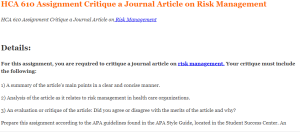HCA 610 Assignment Critique a Journal Article on Risk Management
HCA 610 Assignment Critique a Journal Article on Risk Management
HCA 610 Assignment Critique a Journal Article on Risk Management
Details:![]()
For this assignment, you are required to critique a journal article on risk management. Your critique must include the following:
1) A summary of the article’s main points in a clear and concise manner.
2) Analysis of the article as it relates to risk management in health care organizations.
3) An evaluation or critique of the article: Did you agree or disagree with the merits of the article and why?
Prepare this assignment according to the APA guidelines found in the APA Style Guide, located in the Student Success Center. An

HCA 610 Assignment Critique a Journal Article on Risk Management
abstract is not required.
This assignment uses a grading rubric that can be viewed at the assignment’s drop box. Instructors will be using the rubric to grade the assignment; therefore, students should review the rubric prior to beginning the assignment to become familiar with the assignment criteria and expectations for successful completion of the assignment.
Risk management is the identification, evaluation, and prioritization of risks (defined in ISO 31000 as the effect of uncertainty on objectives) followed by coordinated and economical application of resources to minimize, monitor, and control the probability or impact of unfortunate events[1] or to maximize the realization of opportunities.
Risks can come from various sources including uncertainty in international markets, threats from project failures (at any phase in design, development, production, or sustaining of life-cycles), legal liabilities, credit risk, accidents, natural causes and disasters, deliberate attack from an adversary, or events of uncertain or unpredictable root-cause. There are two types of events i.e. negative events can be classified as risks while positive events are classified as opportunities. Risk management standards have been developed by various institutions, including the Project Management Institute, the National Institute of Standards and Technology, actuarial societies, and ISO standards.[2][3] Methods, definitions and goals vary widely according to whether the risk management method is in the context of project management, security, engineering, industrial processes, financial portfolios, actuarial assessments, or public health and safety.
Strategies to manage threats (uncertainties with negative consequences) typically include avoiding the threat, reducing the negative effect or probability of the threat, transferring all or part of the threat to another party, and even retaining some or all of the potential or actual consequences of a particular threat. The opposite of these strategies can be used to respond to opportunities (uncertain future states with benefits).
Certain risk management standards have been criticized for having no measurable improvement on risk, whereas the confidence in estimates and decisions seems to increase
Use the following coupon code :
NursesHomework
